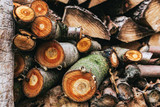Traditional Chinese Medicine and Processing Herbs

Getting into the Flow
A common question that we receive is asking about how our herbs are processed. I’ve written before about what the different extraction ratios and classifications mean (such as standardized versus concentrated), but I have not provided an overall outline of processing here on the blog—though I’ve done so innumerable times through e-mail. My aim here is to better inform our customers as to how raw herbs are processed into concentrated, potent medicines, and through this information, to hopefully better connect people—better connect you—to the plants, not just using plants in place of pharmaceutical drugs, it is forging and cultivating that deep connection to nature that we’ve lost in modern society. To fully embrace herbal medicine, we need to fully embrace that connection.

This flowchart represents the overall method used for processing raw herbs into final products according to Traditional Chinese Medicine (TCM) standards. Unlike herbal traditions in the US or Europe, within Chinese Medicine, specifications exists around every single herb, including where and when the plant is grown, when it is harvested, and how it is processed.
For example, while Astragalus can be grown throughout the world, for Astragalus to be considered a medicine under TCM, it must follow the following:
- Location: Astragalus is grown in the Inner Mongolia Autonomous Region, or the Shanxi and Heilongjiang provinces in China. Though Astragalus grown in the Inner Mongolia Autonomous Region is superior to others.
- Harvest: Only in spring and autumn.
- Smell and Taste: The Astragalus must be slightly sweet with the flavor of beans. Slight smell and sweet, with legumes flavor when chewed.
- Appearance: A coarse texture with straight, long roots and a white – to –white yellow cross section.
- Processing of the Raw Herbs: Astragalus is sliced and left raw in its unprocessed state or may be cooked with honey.
So while there are specifics for each herb and each processing of the herb, the flow-chart holds true. Raw herbs are harvested and sorted. The final selected herbs move onto soaking and cleaning. They are then processed either by slicing, cutting, or grinding. The processed herbs then go onto to be either air dried or heated. Then, if they’ll be extracted, they go onto be processed. You’ll see in the flowchart that at any point after the herbs have been sorted and selected (which includes thorough identification, the herbs can be packaged and sold.
There are several commonly used, typical methods for processing herbs within the tradition of Chinese medicine. This does not include different extraction methods, as extraction happens after the herbs are processed—extraction is done only to herbs which are otherwise ready for consumption.
But before herbs are processed, they must be first sorted and selected, to ensure quality and purity. At this step, any weeds or other plants that may have been inadvertently harvested are discarded, any plants that do not meet the quality control standards are discarded, and any parts of the plants that are not to be used medicinally are discarded (for example, in processing Nettle Root, the above-ground parts would be discarded at this step should they have been harvested). Additionally, the herbs will be washed at this point to clean any dirt or debris from them.
For some plants, washing and soaking is an important step for removing compounds present in the herbs which are unwanted in the final preparation. Some plants may have otherwise unwanted or irritating compounds, some may have excess salt not wanted in the final preparation, and many herbs only need to be cleaned.
After the herbs are sorted, soaked, and cleaned, they’ll be cut, sliced, or ground into the form as dictated by tradition, for processing. Astragalus, for example, will be sliced. The way that the herbs are cut down in this size is important as to how they’ll be processed in the following steps.
At this point, the herbs can undergo their processed into their medicinal state. This can include cooking with honey (as is the case with Zhi Gan Cao—honey fried licorice root), this can include stir-baking (as is the case with Stir-baked Shou Wu), or it can be simple air drying (as is the case with Ren Shen—Chinese Ginseng / Panax ginseng ). In a future blog post, I’ll detail the different processing methods commonly used in Chinese Medicine.
For RAW Forest Foods, we do not offer many unprocessed herbs (with Pine Pollen being the glaring exception). This is because extracts offer a more convenient and cost effective method for using medicine herbs. Extraction can be done either by concentrating the herbs by volume or by isolating a target compound and reducing the herb until a certain concentration has been met. For example, our Cistanche tubulosa is a concentrated extract, where the volume is reduced until a ten-times concentration has been met (10:1). In the final product, each single part—for example, a gram—is equivalent of 10 parts—10 grams—of the raw herb. An example of a standardized extract is our Black Bear Chaga Extract where the active polysaccharide has been isolated and the raw Chaga is reduced until the total polysaccharides present reach 30% of the total weight of the extract.
Recent Posts
Understanding Our Forest Aurum Pine Pollen Nectar Tincture
Unlocking the Potency of Pine Pollen Forest Aurum Pine Pollen Nectar Tincture represents the c...
Unlocking the Secrets of Tongkat Ali: Tradition, Authenticity, and the Power of Natural Healing
Tongkat Ali: A Beacon of Authenticity in the World of Herbal Medicine In our quest to recover o...
Building Product Stacks and Cycles
Unlocking the Intricacies of Stacking, Combining, and Cycling Herbs and Products for Optimum Benefit...
Unlocking the Vital Role of Estradiol in Male Sexual Health: Looking Beyond Testosterone
Exploring the Complex Interplay of Estradiol and Androgens in Male Sexual HealthBeyond the Shadows o...
Witches' Qi Elixir: Eleven Cauldron Flavors
All Hallows Evening: Celebrating Growth, Death, Renewal, and the Mystical Cycles Eleven Cauldron...
Unstandardized Extracts
A Dedication to Excellence Over Quantity In the upcoming week, we are thrilled to reintroduce a...





